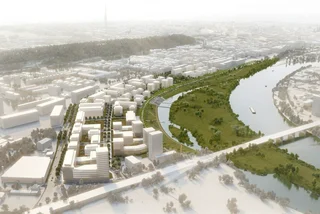Prague’s Nádraží Holešovice metro stop will be transformed into a modern city district to fit in with the larger development of the planned Bubny-Zátory neighborhood. For the first time ever, the Prague Public Transit Company (DPP) will join a private investor to redevelop one of its metro stations. If successful, the same business model will be applied to the redevelopment of other stations in the Czech capital.
Representatives of DPP and Nové Holešovice Development (NHD) last week signed a shareholder agreement that will enable the establishment of the joint venture to revitalize the northern vestibule of the Nádraží Holešovice metro station and transform the surrounding area into a modern city district. The investors of the joint venture are developers Karlín Group and the real estate conglomerate CPI Property Group (CPIPG).
The station’s northern vestibule and immediate surroundings, bordered by rail tracks and Partyzánská, Vrbenského and Argentinská streets will be converted into offices, housing, and services, with an emphasis on public transport and strengthening the interconnections of the existing transport hub, DPP said in a press release.
The exact look of the area will be determined by an international architectural competition. Details have not yet been announced, as the project is in its earliest stages.
DPP will keep a 25 percent stake in the new company Nové Holešovice Development. The remaining shares will eventually be split between Karlín Group and CPI Property Group, subject to the approval of the Office for the Protection of Competition (ÚOHS).
“In the past, the city wasted its valuable land unnecessarily and lost control of it. We've come a long way since then. We don't get rid of the land. We want to further develop it together with private investors,” Prague Deputy Mayor Adam Scheinherr, who is also chairman of the DPP supervisory board, said.
“Thanks to the shared vision, the hitherto bleak territory will gain impetus for further development, but the city will continue to have control over the preservation of transfer connections, the quality of public transport in Prague, and passenger services. At the same time, thanks to the newly formed company, we will obtain a source of financing from private capital for the repair of infrastructure, such as lobbies and metro stations,” he added.
DPP chairman and CEO Petr Witowski said he was glad that DPP managed to successfully implement the first joint venture with private capital to revitalize a metro station. “It was not an easy task, but we knew from the beginning that it would be a long-distance run," he said.
“The joint venture will allow us to achieve several goals: to ensure the necessary revitalization of the metro station and at the same time affect the final shape of the territory, the development of its surroundings, and the transfer links to various types of public transport. At the same time, our long-term strategic interest is not to get rid of land and other assets, but to enhance them, to supplement the offer of shops and services at metro stations, while maintaining full control over its integration into development projects,” he said.
“In addition, this procedure will provide us with long-term revenue sources for the DPP budget and reduce dependence on the Prague budget, without DPP having to make any further investments in the joint venture. Private investors will take care of these. We have created a model according to which we will be able to proceed similarly when modernizing other metro stations,” he concluded.
Serge Borenstein, president of Karlín Group, said he hopes that after demanding negotiations the preparations for the development of the new district can start. “The establishment of a joint venture is good news for Nové Holešovice. We are already looking forward to a quality architectural competition, which will correspond in its international level to the importance of such a fundamental development of the city,” he added.
CPI Property Group executive director Zdeněk Havelka said that group owns more than 240,000 square meters of land in the vicinity of Nádraží Holešovice and in the adjacent Bubny-Zátory area. “I am convinced that our participation in the joint venture will have a synergistic impact on the entire vicinity of Nádraží Holešovice metro station, "he said.
Nádraží Holešovice is part of the metro C line. From when it opened in November 1984 till June 2004 it was that metro line’s final stop, linking passengers to both a commuter railway station and bus depot. Once the metro C line was extended, first to Ládví and later to Letňany, the bus depot lost a lot of its importance.

Until 1990, the station was known as Fučíkova, named after communist-era writer Julius Fučík. After the Velvet Revolution, metro stations linked to communist heroes saw their names changed.
The station is near the northern end of the planned Bubny-Zátory neighborhood, which will fill in a long-neglected brownfield that currently divides Prague 7. The southern part will end near the Vltavska metro stop, also on the metro C line, and will include the Vltava Philharmonic Hall. An architectural contest for the hall, which is expected to become a mew cultural hub for the city, has just been announced.












 Reading time: 4 minutes
Reading time: 4 minutes 





























